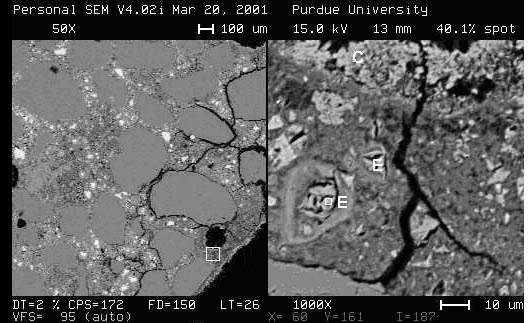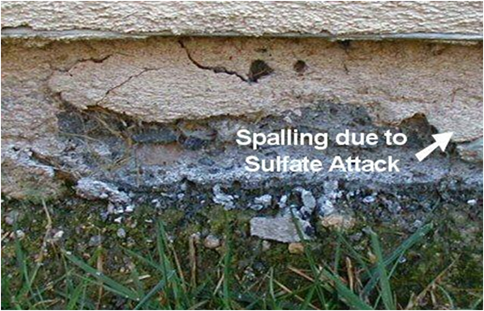Sulfate attack on concrete
Sulfate compounds (such as calcium sulfate, sodium sulfate, and magnesium sulfate) which exist in seawater, ground water, sewers, soil or even in the concrete materials themselves can attack and significantly damage the concrete. There are two types of sulfate attack, namely: chemical (involving chemical interaction between sulfates and concrete compounds) and physical (sulfate salt crystallize inside the concrete pores to cause internal pressure on concrete). In this article, only the chemical sulfate attack will be covered. Regarding, the physical one will be covered in a following article. From now on, the term “sulfate attack” would refer to the chemical type.
As mentioned before, sulfates react with hydrated compounds in the hardened cement paste. These reactions might induce sufficient internal pressure resulting in expansion, spalling of surface layers, loss of strength and ultimately total disintegration of concrete.

Mechanism of Sulfate Attack
Sulfate ions attack calcium hydroxide and the hydration products of C3A, forming gypsum and ettringite in expansive reactions. Depending on the cations involved with SO4 such as Mg and Na, sulfate attack can be more or less aggressive. For instance, magnesium sulfate attacks concrete in a way similar to sodium sulfate but in addition, it forms brucite (magnesium hydroxide). Brucite forms mainly on the surface of concrete; it consumes calcium hydroxide, lowers the pH of the pore solution, and then decomposes the calcium silicate hydrates (C-S-H). In general, magnesium sulfate attack is the most aggressive and calcium sulfate is the least aggressive.
Sulfate Testing
There is no standardized test for concrete sulfate resistance. However, ASTM C1012 can be used define cements as moderately- or highly sulfate resistant. In ASTM C1012, standard mortar bars are exposed to a 5% sulfate solution and expansion is measured with time. Under these severe conditions, expansions of less than 0.10% after 6 months indicate moderate sulfate resistance and expansions less than 0.05% at 6 months (or less than 0.10% at 12 months), indicate high sulfate resistance.
Methods to Control Sulfate Attack
- Using sulfate-resistant cement with Types II or V, depending on the sulfate exposure class as defined by the code. For instance, ACI 318 defines 4 exposure classes, S0 to S3, for concrete, depending on the sulfate content in the soil or groundwater (S3 is the most severe).
- Limit the ability of the sulfates to enter the concrete by reducing the permeability of the concrete (minimizing the water-to-cementitious materials ratio and providing good curing).
- In very severe sulfate exposures, a waterproof barrier protecting the concrete can be beneficial.
